| Listing 1 - 6 of 6 |
Sort by
|
Book
ISBN: 9782867815881 2867815886 Year: 2009 Volume: *2 Publisher: Pessac Presses universitaires de Bordeaux
Abstract | Keywords | Export | Availability | Bookmark
 Loading...
Loading...Choose an application
- Reference Manager
- EndNote
- RefWorks (Direct export to RefWorks)
Lauréat du prix Nobel de littérature en 1969, Samuel Beckett (né à Dublin en 1906 et mort à Paris en 1989), certainement le plus français des écrivains irlandais, a modifié notre façon d'envisager l'art de raconter des histoires, et celui de montrer les corps au théâtre. Ce petit livre revient sur sa carrière étonnante comme romancier et dramaturge, mais aussi comme essayiste, traducteur et auto-traducteur, et sur une oeuvre qui a jalonné toutes les grandes crises du XXe siècle. Il prend le parti de suivre au plus près l'imaginaire d'un auteur réputé difficile, depuis ses romans les plus foisonnants écrits dans le sillage de Joyce, jusqu'aux textes très austères et minimalistes des dernières décennies.
Mothers in literature. --- Mères dans la littérature --- Hysteria in literature. --- Hystérie dans la littérature --- Beckett, Samuel, --- Characters --- Women. --- Criticism and interpretation. --- Mères dans la littérature --- Hystérie dans la littérature --- Beckett, Samuel, - 1906-1989 - Criticism and interpretation. --- Beckett, Samuel, - 1906-1989
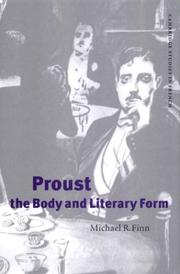
ISBN: 0521641896 0521027543 1107116295 0511117329 0511005075 0511149417 0511309643 0511485751 1280161949 0511051638 9780511005077 051103640X 9780511036408 9780521641890 9780511117329 9780511485756 9781107116290 9781280161940 9780511149412 9780511309649 9780511051630 Year: 1999 Volume: 59 Publisher: Cambridge, U.K. New York, N.Y., U.S.A. Cambridge University Press
Abstract | Keywords | Export | Availability | Bookmark
 Loading...
Loading...Choose an application
- Reference Manager
- EndNote
- RefWorks (Direct export to RefWorks)
This 1999 study examines the connections between Proust's fin-de-siècle 'nervousness' and his apprehensions regarding literary form. Michael Finn shows that Proust's anxieties both about bodily weakness and about novel-writing were fed by a set of intriguing psychological and medical texts, and were mirrored in the nerve-based afflictions of earlier writers including Flaubert, Baudelaire, Nerval and the Goncourt brothers. Finn argues that once Proust cast off his concerns about being a nervous weakling he was freed to poke fun both at the supposed purity of the novel form. Hysteria - as a figure and as a theme - becomes a key to the Proustian narrative, and a certain kind of wordless, bodily copying of gesture and event is revealed to be at the heart of a writing technique which undermines many of the conventions of fiction.
Neuroses in literature. --- Hysteria in literature --- Proust, Marcel, --- Criticism and interpretation. --- Hysterie in de literatuur --- Hystérie dans la littérature --- Neurosen in de literatuur --- Neuroses in literature --- Névroses dans la littérature --- Proust, Marcel --- Criticism and interpretation --- Arts and Humanities --- Literature --- Hysteria in literature. --- Prust, Marselʹ, --- Proust, Valentin Louis Georges Eugène Marcel, --- Pʻŭrusŭtʻŭ, Marŭsel, --- Pʻu-lu-ssu-tʻe, --- Пруст, Марсель, --- פרוסט, מארסל --- פרוסט, מרסל --- ,פרוסט, מרסל --- بروست، مارسيل،, --- Proust, Marcel, - 1871-1922 - Criticism and interpretation. --- Proust, Marcel, - 1871-1922
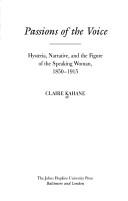
ISBN: 0801851629 Year: 1996 Publisher: Baltimore ; London Johns Hopkins University Press
Abstract | Keywords | Export | Availability | Bookmark
 Loading...
Loading...Choose an application
- Reference Manager
- EndNote
- RefWorks (Direct export to RefWorks)
Différences entre sexes (Psychologie) dans la littérature --- Hysteria in literature --- Hysterie in de literatuur --- Hystérie dans la littérature --- Narration (Rhetoric) --- Narration (Rhétorique) --- Narrative writing --- Parole (Linguistique) dans la littérature --- Seksuele verschillen (Psychologie) in de literatuur --- Sex differences (Psychology) in literature --- Speech in literature --- Spraak in de literatuur --- Stem in de literatuur --- Verhaal (Retoriek) --- Voice in literature --- Voix dans la littérature --- 82:396 --- Literatuur en feminisme --- 82:396 Literatuur en feminisme --- English fiction --- Modernism (Literature) --- Psychoanalysis and literature --- Women and literature --- Literature --- History and criticism --- History --- 20th century --- Great Britain --- Psychoanalysis and literature - Great Britain - History. --- Rhetoric --- Discourse analysis, Narrative --- Narratees (Rhetoric)
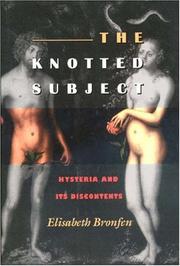
ISBN: 069101230X 0691012318 9780691012308 0691608377 1400864739 130698386X 0691636842 9781400864737 9780691012315 9780691608372 Year: 1998 Publisher: Princeton, N.J. Princeton University Press
Abstract | Keywords | Export | Availability | Bookmark
 Loading...
Loading...Choose an application
- Reference Manager
- EndNote
- RefWorks (Direct export to RefWorks)
Surrealist writer André Breton praised hysteria for being the greatest poetic discovery of the nineteenth century, but many physicians have since viewed it as the "wastebasket of medicine," a psychosomatic state that defies attempts at definition and cure and that can be easily mistaken for other pathological conditions. In light of a resurgence of critical interest in hysteria, leading feminist scholar Elisabeth Bronfen reinvestigates medical writings and cultural performance to reveal the continued relevance of a disorder widely thought to be a romantic formulation of the past. Through a critical rereading, she develops a new concept of hysteria, one that challenges traditional gender-based theories linking it to dissatisfied feminine sexual desire. Bronfen turns instead to hysteria's traumatic causes, particularly the fear of violation, and shows how the conversion of psychic anguish into somatic symptoms can be interpreted today as the enactment of personal and cultural discontent.Tracing the development of cultural formations of hysteria from the 1800s to the present, this book explores the writings of Freud, Charcot, and Janet together with fictional texts (Radcliffe, Stoker, Anne Sexton), opera (Mozart, Wagner), cinema (Cronenberg, Hitchcock, Woody Allen), and visual art (Marie-Ange Guilleminot, Cindy Sherman). Each of these creative works attests to a particular relationship between hysteria and self-fashioning, and enables us to read hysteria quite literally as a language of discontent. The message broadcasted by the hysteric is one of vulnerability: vulnerability of the symbolic, of identity, and of the human body itself.Throughout this work, Bronfen not only offers fresh approaches to understanding hysteria in our culture, but also introduces a new metaphor to serve as a theoretical tool. Whereas the phallus has long dominated psychoanalytical discourse, the image of the navel--a knotted originary wound common to both genders--facilitates discussion of topics relevant to hysteria, such as trauma, mortality, and infinity. Bronfen's insights make for a lively, innovative work sure to interest readers across the fields of art and literature, feminism, and psychology.Originally published in 1998.The Princeton Legacy Library uses the latest print-on-demand technology to again make available previously out-of-print books from the distinguished backlist of Princeton University Press. These editions preserve the original texts of these important books while presenting them in durable paperback and hardcover editions. The goal of the Princeton Legacy Library is to vastly increase access to the rich scholarly heritage found in the thousands of books published by Princeton University Press since its founding in 1905.
Psychological study of literature --- Thematology --- Film --- Depth psychology --- Hysteria --- Hysteria in literature --- Hysteria in motion pictures --- Hysterical neuroses --- Hysterie --- Hysterie in de film --- Hysterie in de literatuur --- Hystérie --- Hystérie dans la littérature --- Hystérie dans le cinéma --- 82:159.9 --- Literatuur en psychologie. Literatuur en psychoanalyse --- Hysteria in literature. --- Hysteria in motion pictures. --- Hysteria. --- Navel --- Psychoanalyse --- Symbolic aspects. --- cultuur en religie --- 82:159.9 Literatuur en psychologie. Literatuur en psychoanalyse --- cultuur en religie. --- Mass Media --- Histrionic Personality Disorder --- History --- Philosophy --- Humanities --- Abdomen --- Audiovisual Aids --- Personality Disorders --- Educational Technology --- Teaching Materials --- Communications Media --- Body Regions --- Technology --- Information Science --- Mental Disorders --- Anatomy --- Technology, Industry, and Agriculture --- Psychiatry and Psychology --- Technology, Industry, Agriculture --- Motion Pictures as Topic --- Symbolism --- Umbilicus --- Literature --- Psychiatry --- Health & Biological Sciences --- Psychiatric Disorders, Individual --- Symbolic aspects --- Belly button --- Omphalos --- Hysteric passion --- Hysterica passio --- Hysterical neurosis --- Hysterical passion --- Passio hysterica --- Vapors (Disease) --- Vapours (Disease) --- Umbilical cord --- Motion pictures --- Neuroses --- Ecstasy --- Navel - Symbolic aspects.
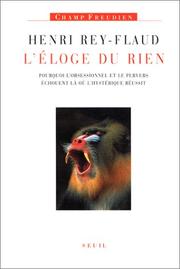
ISBN: 2020257114 9782020257114 Year: 1996 Volume: *6 Publisher: Paris : Editions du Seuil,
Abstract | Keywords | Export | Availability | Bookmark
 Loading...
Loading...Choose an application
- Reference Manager
- EndNote
- RefWorks (Direct export to RefWorks)
Afwijkingen [Seksuele ] --- Compulsive disorder --- Deviant sexual behavior --- Deviation [Sexual ] --- Deviations [Sex ] --- Dwangmatige neurosen --- Déviation sexuelle --- Déviations sexuelles --- Fixed ideas --- Hysteria --- Hysterical neuroses --- Hysterie --- Hystérie --- Neurosen [Dwangmatige ] --- Névroses obsessionnelles --- OCD (Disease) --- Obsession (Psychology) --- Obsessive-compulsive disorder --- Obsessive-compulsive neuroses --- Obsessive-compulsive neurosis --- Parafilie --- Parafilies --- Parafiliëen --- Paraphilias --- Paraphilie --- Paraphilien --- Perversie [Seksuele ] --- Perversion [Sexual ] --- Perversion sexuelle --- Perversions sexuelles --- Seksuele afwijkingen --- Seksuele perversie --- Sexual deviation --- Sexual perversion --- Sexualite -- Perversion --- TOC (Maladie) --- Troubles obsessionnels compulsifs --- Hysteria in literature --- Obsessive-compulsive disorder in literature --- Psychoanalysis and literature --- Hystérie dans la littérature --- Névroses obsessionnelles dans la littérature --- Psychanalyse et littérature --- Molière, --- --Molière, --- Psychoanalysis --- Don Juan --- --Psychanalyse --- --Molière, --- Hystérie dans la littérature --- Névroses obsessionnelles dans la littérature --- Psychanalyse et littérature --- Molière, --- Psychoanalysis and literature - France --- Psychanalyse --- Molière, - 1622-1673 - Dom Juan --- Molière, 1622-1673
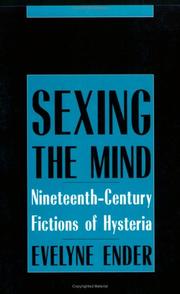
ISBN: 0801480833 Year: 1995 Publisher: Ithaca (N.Y.): Cornell university press
Abstract | Keywords | Export | Availability | Bookmark
 Loading...
Loading...Choose an application
- Reference Manager
- EndNote
- RefWorks (Direct export to RefWorks)
Femme (Théologie chrétienne) dans la littérature --- Femmes dans la littérature --- Femmes dans la poésie --- Femmes dans le théâtre --- Hysteria in literature --- Hysterie in de literatuur --- Hystérie dans la littérature --- Literature and psychoanalysis --- Literatuur en psychoanalyse --- Littérature et psychanalyse --- Psychanalyse et littérature --- Psychoanalyse en literatuur --- Psychoanalysis and literature --- Sekse (Psychologie) in de literatuur --- Sex (Psychology) in literature --- Sexe (Psychologie) dans la littérature --- Vrouw (Christelijke theologie) in de literatuur --- Vrouwen in de literatuur --- Vrouwen in de poëzie --- Vrouwen in het toneel --- Woman (Christian theology) in literature --- Women in drama --- Women in literature --- Women in poetry --- Comparative literature --- Fiction --- Hysteria in literature. --- Psychoanalysis and literature. --- Psychological fiction --- Sex (Psychology) in literature. --- Women in literature. --- American and French. --- French and American. --- History and criticism. --- Psychoanalytic literary criticism --- Literature --- American and French --- French and American --- History and criticism --- James, Henry, --- Sand, George, --- Dudevant, Amantine Lucile Aurore Dupin, --- Zand, Zhorzh, --- Dupin, Aurore, --- Dudevant, Aurore, --- Sand, Zhorzh, --- Dupin, Amandine-Aurore-Lucile, --- Dudevant, Amandine-Aurore-Lucile, --- Dupin, Armandine Aurore Lucille, --- Sand, Jules, --- Sand, J., --- George, --- זאנד, זשארזש --- סאנד, זשארזש --- סנד, ז׳ורז׳, --- Sand, Georges, --- Knowledge --- Psychology. --- James, Henry --- 19th century --- Literature [Comparative ] --- Psychology --- Sand, George --- James, Henry, - 1843-1916 - Knowledge - Psychology. --- Sand, George, - 1804-1876 - Knowledge - Psychology. --- Dzheĭms, G. --- Dzheĭms, Genri, --- Jeimsŭ, Henri, --- Джеймс, Генри, --- ג׳יימס, הנרי, --- ג׳ײמס, הנרי, --- Τζειος, Χενρι, --- جميس، هينري، --- جيمز، هنرى
| Listing 1 - 6 of 6 |
Sort by
|

 Search
Search Feedback
Feedback About UniCat
About UniCat  Help
Help News
News